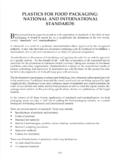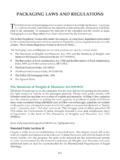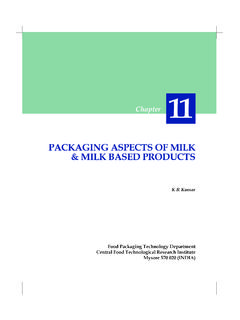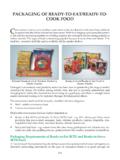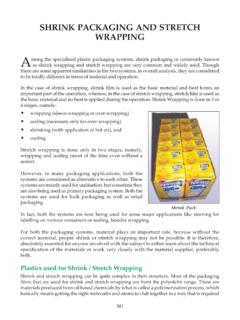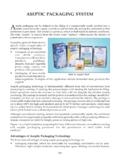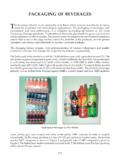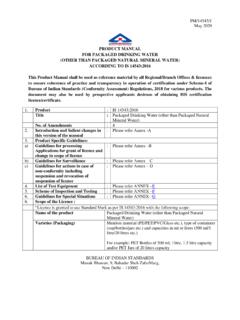Transcription of FOOD GRADE QUALITY OF PLASTICS AND REGULATIONS
1 47 PLASTICS IN food PACKAGINGFOOD GRADE QUALITY OF PLASTICS AND REGULATIONSC hapter3 food GRADE QUALITYOF PLASTICS ANDREGULATIONSB aldev RajFood packaging Technology DepartmentCentral food Technological Research InstituteMysore 570 020 (INDIA)48 PLASTICS IN food PACKAGINGC hapter 349 PLASTICS IN food PACKAGINGFOOD GRADE QUALITY OF PLASTICS AND REGULATIONSC hapter 3 food GRADE QUALITY OFPLASTICS AND REGULATIONSROLE OF ADDITIVES INPLASTICSIn addition to the basic polymers, plasticsalso contain additional chemical compo-nents called additives, which are added insmall amounts to alter the properties of thepolymers in the desired way and/or simplifytheir processing.
2 Only fillers and softeners(plasticizers) are used at high concentrationto increase volume and/or weight to improvesoftening, flexibility, elasticity, malleabilityand processability. Other additives aremostly low molecular weight componentslike stabilizers, anti-oxidants, antistaticagents, light stabilizers (UV absorbers),lubricants (slip agents), optical brighteners,etc. Polymer packaging materials may alsocontain small quantities of monomers,oligomers as well as polymerization catalystsand regulators, cross-linking agents,emulsifer agents, etc.
3 These additives alongwith low molecular weight non-polymericcomponents, which occur from plasticpackaging materials, possess high is likely that some transfer of low-molecularweight non-polymeric components willoccur from the plastic packaging materialinto the packaged content, therebycontaminating the product with the risk oftoxic hazard to the consumer. However, it isto be remembered that useful properties ofthe PLASTICS are not manifested without theaddition of these additives. Therefore,guidelines for proper use of PLASTICS for foodpackaging applications have beenformulated all over the world, which arenecessary to safeguard health of over the safety-in-use of plasticsas food packaging materials arisesprincipally from the possible toxicity of otherlow molecular weight constituents that maybe present in the package and hence, getleached into the foodstuff during storage.
4 Asstated above, such constituents arise fromtwo sources:Polymerisation residues includingmonomers, oligomers (with a molecularweight up to about 200), catalysts (mainlymetallic salts and organic peroxides),solvents, emulsifiers and wetting agents, rawmaterial impurities, plant contaminants,inhibitors, decomposition and side more volatile gaseous monomers,such as ethylene, propylene and vinylchloride, usually fall in concentration with50 PLASTICS IN food PACKAGINGC hapter 3time, but very low levels may persist in thefinished product almost indefinitely.
5 Styreneand acrylonitrile residues are more difficultto aids such as antioxidants,antiblock agents, antistatic agents, heat andlight stabilizers, plasticisers, lubricants andslip agents, pigments, fillers, mould releaseagents and fungicides are added to assistproduction processes or to enhance theproperties and stability of the final may be present in amounts varyingfrom only a few parts per million up toseveral parts per compounds of the first group arepresent inadvertently, there is not much thatcan be done to remove them. However, theefforts made by the industry to reduce vinylchloride monomer levels in particular,illustrates the advantages of optimummanufacturing processes on the purity ofthe final product.
6 Chemicals added delibe-rately during formulation to alter theprocessing, mechanical or other propertiesof the polymer are likely to be present ingreater amounts than polymerizationresidues and should be subjected to strictquality control. They are normally restrictedto compounds appearing on an approvedlist for food contact use. A brief account ofthe functions of some major additives ispresented below:Antiblock AgentsThese are added to roughen the surfaceof thin films and, hence, prevent themsticking together during machine is most commonly used because itspoor solubility in most polymers helps toincrease the surface concentration and sointroduces irregularity.
7 Similarly, slipadditives such as fatty acids and amides areused to reduce prevent degradation of the polymerby reacting with atmospheric oxygen duringmoulding operations at high temperaturesor when used in contact with hot foods andto prevent deterioration during storage. Deri-vatives of phenols and organic sulphidesare the most frequently used of these compounds are classified asheat AgentsSince all PLASTICS are good electricalinsulators (and are in fact used on a largescale for this purpose) they will retainelectrostatic charges produced by frictionfrom contact with processing of static electricity can causeproblems through the pick-up of dust,adhesion between layers or particles ofplastics, sparking, electrical shock andpossibly fire hazards.
8 Most antistatic agentsare glycol derivatives or quaternary ammo-nium compounds; both increase the electricalconductivity and plate-out onto the surfaceof are added to reduce frictionalforces and are usually low to mediummolecular weight hydrocarbons. Theyshould possess good solubility with theplastic, low volatility and be relatively are added to make the productmore flexible and less brittle. They are usuallyhigh molecular weight esters. The plasticizeralso gives the material the limp and tackyqualities found in cling films. About 80%of all plasticizers are used in PVC.
9 Typically51 PLASTICS IN food PACKAGINGFOOD GRADE QUALITY OF PLASTICS AND REGULATIONS phthalic esters such as dioctyl phthalate(DOP), also known as di-2-ethylhexyladipate(DEHA) are used as StabilizersThese are needed to protect the productfrom deterioration by sunlight or evensupermarket lighting. Products containingvitamin C are particularly susceptible to thisform of Property ModifiersThe optical properties of a material froma technological aspect are normally describedin terms of their ability to transmit light, toexhibit colour and reflect light from thesurface ( , gloss).
10 The majority of foodpackaging films are unpigmented, but someare coloured by the addition of principal pigments used as colourantsin packaging are carbon black, whitetitanium dioxide, red iron oxide, yellowcadmium sulfide, molybdate orange,ultramarine blue, blue ferric ammonium ferricammonium, ferrocyanide, chrome green, andblue and green copper RetardantsAlthough most packaging materials arecombustible, their lack of flame resistance isdisregarded in most food packagingapplications. For example, thermoformedpolystyrene cups and plates are combus-tible; the risk of fire must be balanced againstthe possible toxicity of flame AgentsFoaming or blowing agents are used forthe production of cellular products and arenormally classified into physical andchemical types, according to whether thegeneration of gases to produce the cells takesplace through a physical transition or sublimation or by a chemicalprocess decomposition reactions whichresult in evolution of gases.
